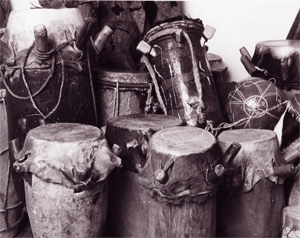
Tanbou
 The
Haitian drum (tanbou) is an
important instrument to preserve and
play. Without the drum, our culture
would be lost. The lineage of the
Haitian drum is complex, originating
in Africa’s Vodun systems. A
drum must be crafted properly and
baptized in order to sound good and
do the job. I met a man from Nigeria
who was studying drum history in Haiti.
He was delighted and surprised to
hear the Banda- rhythm was being kept
alive by Haitian drummers since he
claimed it was no longer used in Nigeria.
Haiti is a hotbed for African drumming.
Popular focus is typically on Cuba-
and Brazil -- but our rhythms are
a well-kept secret.
The
Haitian drum (tanbou) is an
important instrument to preserve and
play. Without the drum, our culture
would be lost. The lineage of the
Haitian drum is complex, originating
in Africa’s Vodun systems. A
drum must be crafted properly and
baptized in order to sound good and
do the job. I met a man from Nigeria
who was studying drum history in Haiti.
He was delighted and surprised to
hear the Banda- rhythm was being kept
alive by Haitian drummers since he
claimed it was no longer used in Nigeria.
Haiti is a hotbed for African drumming.
Popular focus is typically on Cuba-
and Brazil -- but our rhythms are
a well-kept secret.
Haitian drums are fun to play, producing an organic, versatile sound that can be used for dance, professional recording, healing and merry making. I use my drums to play all kinds of styles. Kids love them too.
The drum has survived centuries and those who use it should do so seriously. My drum collection is very important to me; some are from the oldest temples in Haiti. The older the drum, the better the sound!
There are several varieties of Haitian drums each with an African origin and distinct family of rhythms (see below). Most rhythms require 3 drummers. Rada for example is always played with three drums including the Manman, Segon and a Boula. It all depends on what part of Haiti and how the tradition manifested.
My son and I build and fix drums - using hard wood - tronpèt, bwachen, gomyé - and goat or cow skin. Our drums can be used like regular congas. It is very difficult to get drums from Haiti into America. Crafting them is equally challenging due to the finding the right wood and particularly the skins which must be procured under exact conditions.
 Here
are a just a few of the rhythm families
we work with regularly:
Here
are a just a few of the rhythm families
we work with regularly:
Dahomey represents a large family of rhythms, dances and songs from the Dahomey nation that manifest Haiti’s north provinces (Gonaive, Souvenance, Badjo).
Three cow-skin drums - Katabo, Gonde, Manman - are played by three people using 2 sticks, hand &bow (agida), and 1 hand/1 stick, respectively.
Dahomey rhythms include:
- Wandjalé
- Chasè
- Akbadja
- Agoni
Dahomey are played for Ayisan, Danbala, Legba, Ogoun and Manbo Lisa.
Rada
Rada drums also play rhythms from the Dahomey nation but with subtle differences in sound from those of Dahomey north (see above) A trained ear can notice the difference. Rada rhythms, songs and dances manifest in the south and central provinces of Haiti (La Plaine, Port Au Prince central, Jacmel).
Three cow-skin drums - Boula, Segon, Manman - are played by three people using stick, hand and bow similar to the Dahomey.
Rada rhythms include:
- Yanvalou
- Mayi
- Zepol
- Nago
- Ibo
Rada
are played for the same Dahomey spirits
but again the sounds, dances and songs
are slightly different.
Petwo is a family of rhythms originating in Haiti’s central and southern regions (La Plaine, Port au Prince, Akayè). Petwo drums are hot and are played for Papa Simbi, Ezili Danto, Gran Bwa amongst others.
Petwo includes the Kita rhythm where two goat-skin drums - Ralé and Manman - are played by hand only.
YaYa TiKongo is a very powerful family of unique Kongo rhythms from Haiti’s north (Soukri Danash). YaYa Ti Kongo drums are strong and played for Ganga, Madanlawe amongst others. YaYa TiKongo includes the Mambo rhythm where two goat skin drums — Manman and Rale — are played by hand only.
RARA are distinct drums, songs, rhythms and dances found in the North, South and East region of Haiti. RaRa drums are played for celebrations where several spirits are honored particularly those of Petwo. Drums are played while walking along with horns, bells and maracas. Rara is -is played on a goat-skin drum (Rara) while walking, standing or sitting.
There are hundreds of other
Haitian rhythms and drums style, too extensive to mention here. If you
would like to know more about our drums please email me at bonga@bongamusic.com or call me at 917-447-3278. For info about our DRUM WORKSHOPS, please
see the Adults Workshops page.

